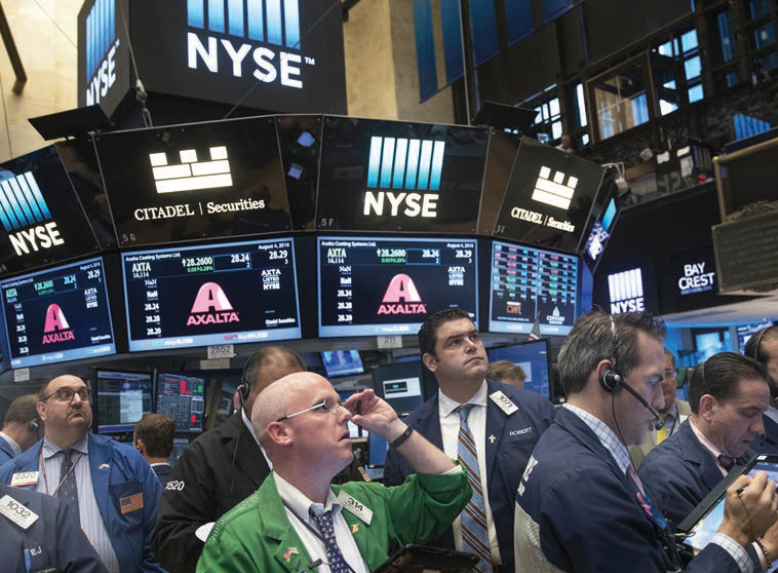By Brice Wallace
John Tousley has some advice for stockholders who believe a recession will happen sometime in the next two years.
“You do nothing.”
Speaking at a Salt Lake City Rotary Club luncheon last week, the Goldman Sachs executive said that while an economic model pegs the risk of a recession at 33 percent — it was 19 percent a year ago — historic data indicates that stock market returns two years before a recession hits is about 21 percent. That’s the same level as last year’s S&P 500 returns.{mprestriction ids="1,3"}
“Now, I’m not here to say we’re at that two-year point,” said Tousley, global head of U.S. market strategy for Goldman Sachs’ Strategic Advisory Solutions. “But the point is, [in] the later innings of an economic cycle, the sun is shining, you make hay as an investor.”
He predicts 2018 to result in “reasonably solid returns” for stockholders and that they should avoid making major moves in their portfolios. “The data right now would say it’s too early to de-risk,” he said.
Tousley, however, cautioned that stockholders need to be realistic, predicting that those returns could “moderate.”
“What we know from history is that 99 percent of the time, when a stock market has been valued similarly to what it is today, your returns will be single digits or below. I can’t tell you what the end of this year is going to exactly look like or the next couple of years, but I can tell you with a high degree of statistical confidence that what we’re looking at is moderating equity returns moving forward,” said Tousley, who graduated in 1991 with a degree in economics from Brigham Young University.
“More risk in the market and less return – that’s a normal cyclical pattern, by the way. I’m not telling you something that this market has not experienced many, many times. But the reality is, if you’re thinking about longer-term investments, you should expect equities to return less than what they’ve been generating for you the last three to five years.”
As he did during remarks to the Rotary Club a year ago, Tousley instructed the audience to ignore comments tying the end of the post-recession expansion to its age. The current expansion has reached 105 months — it’s the second-oldest and second-largest in accumulated returns — while most recent expansions lasted an average of 72 months.
“Often people will say, ‘Well, we must be in the 13th or the 14th inning of a game. The end is near.’ And that is just not good economic theory. The reality is age of expansion and recession have virtually no relationship. At the end of the day, most economic expansions don’t die of old age: they’re murdered by the Fed.”
Tousley later clarified to say that the Federal Reserves’ countercyclical approach kills not all expansions, but instead three out of four.
“We’re old,” he said of the current expansion, “but do not let that worry you. When you start to hear this narrative that because we’re old, the end is near, there’s just no math behind that.”
Generally, Tousley said 2018 should be a lot like 2017 from an economic standpoint and that equities have the best potential for returns among investments generally associated with volatility.
“We believe equities continue to represent probably the best risk-adjusted return potential. That does not mean they’re cheap. It does not mean that you should be backing up the truck to equities at this point. But it does mean that, relative to other risk assets, they remain our favorite,” he said.
The current stock market is characterized by stability, he said. The S&P 500 last year reached all-time highs 64 times, but it grew above 1 percent during a trading day only four times and fell more than 1 percent that same number.
“2017 is the quintessential example of the turtle winning the race,” Tousley said. “This was a steady, stable equity market driven by predictable fundamentals. It’s a good place to be. My only fear I have is I don’t think it can get any better than what we experienced in 2017. I think it will get a little harder, a little more noisy with the data.”
He predicts U.S. GDP growth to rise from 2.2 percent in 2017 to 2.4 percent this year, and inflation should be stable. Meanwhile, macroeconomic volatility is low despite uncertainty regarding policy both in the U.S. and around the world. The markets are “paying attention to the things that matter” and ignoring useless information, he said.
“The fact is the markets are saying, ‘I know there’s a goofy headline on every website out there, on every newspaper, but the fundamentals are much better than the headlines,’” Tousley said. “So, while there is all kinds of political uncertainty and tweets and all this new world that we live in that creates a lot of white noise, the market voted and said, ‘We think the fundamentals are better than the noise.’”{/mprestriction}








